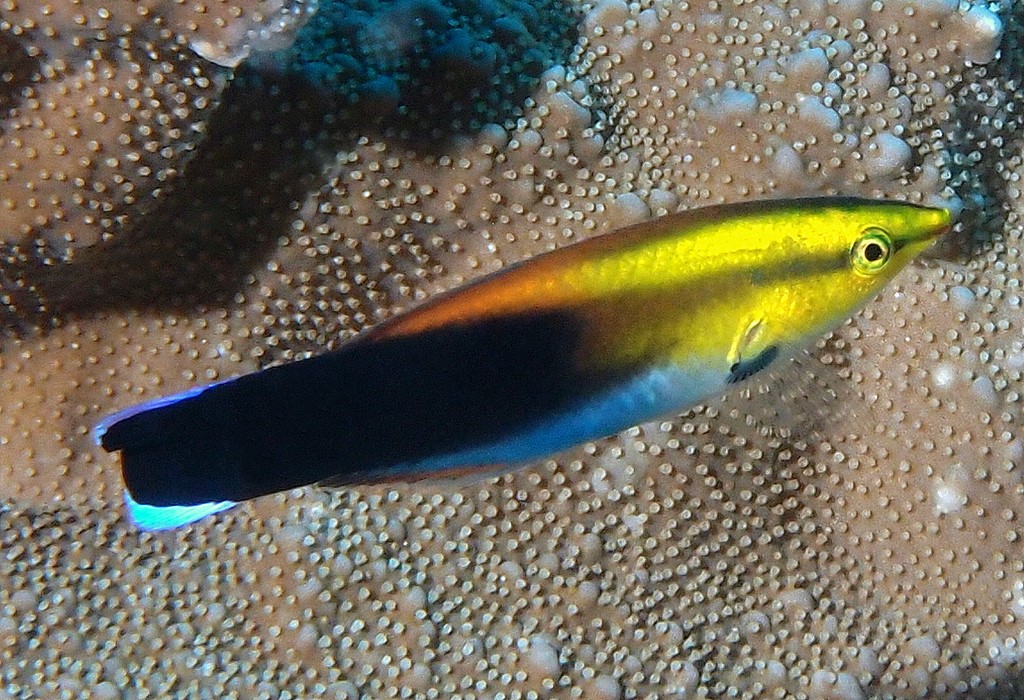LABROIDES PECTORALIS - (RANDALL & SPRINGER, 1975)
Actinopterygii (Gigaclass) > Actinopteri (Class) > Teleostei (Subclass) > Labriformes (Order) > Labroidei (Suborder) > Labridae (Family) > Labroides (Genus)
Nettoyeur à tache noire, Black-spot cleaner wrasse, Breastspot cleanerfish, False bluestreak wrasse, Yellow cleaner, Spotbreast cleanerfish, Breastspot cleaner wrasse, Sumitsuki-somewakebera, スミツキソメワケベラ, 胸斑裂唇魚,
Description
Dorsal spines (total): 9; Dorsal soft rays (total): 10-12 (usually: 11); Anal spines: 3; Anal soft rays: 9-11 (rarely: 9); Pectoral fin rays: 13; Lateral line scales: 26. Scales on lateral line: 28 (+2 past hypural). Body depth: 3.3-3.92 in SL. Cheek, opercle and most of nape scaled; Lips and dentition as in genus; Caudal fin slightly rounded. Max. length: 11.0 cm TL. Depth range: 2 - 30 m.
Color
Adult with a black stripe from snout through eye to end of caudal fin, this stripe progressively broader as it passes posteriorly; A median dorsal black stripe from snout tip to dorsal fin; Head and anterior body between black stripes yellow, this color gradually changing to orange posterioly; Body below lateral stripe blue; A black spot nearly as large as eye at lower edge of pectoral fin base; Lips orange-red and blackish; Upper and lower edges of caudal fin lavender-pink, the corner hyaline.
Etymology
Labroides: from Latin, labrum = lip + from Latin suffix, -oides = similar to.
pectoralis: from Latin, pectoralis = chest, pectoral. Referring to large black spot below pectoral-fin base.
Original description: Labroides pectoralis Randall & Springer, 1975 - Type locality: Reef about 1 mile southeast of Auluptagel Island, Palau Islands, Philippine Sea, depth 6-10 feet.
Distribution
Eastern Indian Ocean, western Pacific: Christmas and Cocos-Keeling islands, east to Micronesia and New Ireland (Papua New Guinea), north to Philippines and Ogasawara Islands, south to northern Australia and New Caledonia.
Nettoyeur à tache noire, Black-spot cleaner wrasse, Breastspot cleanerfish, False bluestreak wrasse, Yellow cleaner, Spotbreast cleanerfish, Breastspot cleaner wrasse, Sumitsuki-somewakebera, スミツキソメワケベラ, 胸斑裂唇魚,
Description
Dorsal spines (total): 9; Dorsal soft rays (total): 10-12 (usually: 11); Anal spines: 3; Anal soft rays: 9-11 (rarely: 9); Pectoral fin rays: 13; Lateral line scales: 26. Scales on lateral line: 28 (+2 past hypural). Body depth: 3.3-3.92 in SL. Cheek, opercle and most of nape scaled; Lips and dentition as in genus; Caudal fin slightly rounded. Max. length: 11.0 cm TL. Depth range: 2 - 30 m.
Color
Adult with a black stripe from snout through eye to end of caudal fin, this stripe progressively broader as it passes posteriorly; A median dorsal black stripe from snout tip to dorsal fin; Head and anterior body between black stripes yellow, this color gradually changing to orange posterioly; Body below lateral stripe blue; A black spot nearly as large as eye at lower edge of pectoral fin base; Lips orange-red and blackish; Upper and lower edges of caudal fin lavender-pink, the corner hyaline.
Etymology
Labroides: from Latin, labrum = lip + from Latin suffix, -oides = similar to.
pectoralis: from Latin, pectoralis = chest, pectoral. Referring to large black spot below pectoral-fin base.
Original description: Labroides pectoralis Randall & Springer, 1975 - Type locality: Reef about 1 mile southeast of Auluptagel Island, Palau Islands, Philippine Sea, depth 6-10 feet.
Distribution
Eastern Indian Ocean, western Pacific: Christmas and Cocos-Keeling islands, east to Micronesia and New Ireland (Papua New Guinea), north to Philippines and Ogasawara Islands, south to northern Australia and New Caledonia.
Biology
Inhabits coral-rich areas of seaward and clear lagoon reefs. Occur solitarily or in pairs. Creates 'cleaning' stations to which fishes come to have crustacean ectoparasites and mucus removed. Oviparous, distinct pairing during breeding. Aquarium fish.
Inhabits coral-rich areas of seaward and clear lagoon reefs. Occur solitarily or in pairs. Creates 'cleaning' stations to which fishes come to have crustacean ectoparasites and mucus removed. Oviparous, distinct pairing during breeding. Aquarium fish.
Similar species
- Aspidontus dussumieri (Valenciennes, 1836) - Reported from New Caledonia - Link to the species (here).
- Aspidontus taeniatus (Quoy & Gaimard, 1834) - Reported from New Caledonia - Link to the species (here).
- Cheilodipterus parazonatus (Gon, 1993) - Reported from Western Pacific: Indonesia east to New Ireland (Papua New Guinea), south to Great Barrier Reef (Queensland, Australia) and Solomon Islands.
- Coris musume (Jordan & Snyder, 1904) - Reported from Western Pacific: Taiwan north to Japan.
- Coris picta (Bloch & Schneider, 1801) - Reported from New Caledonia - Link to the species (here).
- Hologymnosus annulatus (Lacepède, 1801) - Reported from New Caledonia - Link to the species (here).
- Labroides rubrolabiatus (Randall, 1958) - Report from New Caledonia need verification.
- Larabicus quadrilineatus (Rüppell, 1835) - Reported from Red Sea; Northwestern Indian Ocean: Gulf of Aden, Socotra (Yemen), Persian Gulf.
- Malacanthus latovittatus (Lacepède, 1801) - Reported from New Caledonia - Link to the species (here).
- Meiacanthus vittatus (Smith-Vaniz, 1976) - Reported from Western Pacific: Papua New Guinea, including New Britain.
- Plagiotremus rhinorhynchos (Bleeker, 1852) - Reported from New Caledonia - Link to the species (here).
- Plagiotremus tapeinosoma (Bleeker, 1857) - Reported from New Caledonia - Link to the species (here).
Last update: 6, August 2023
